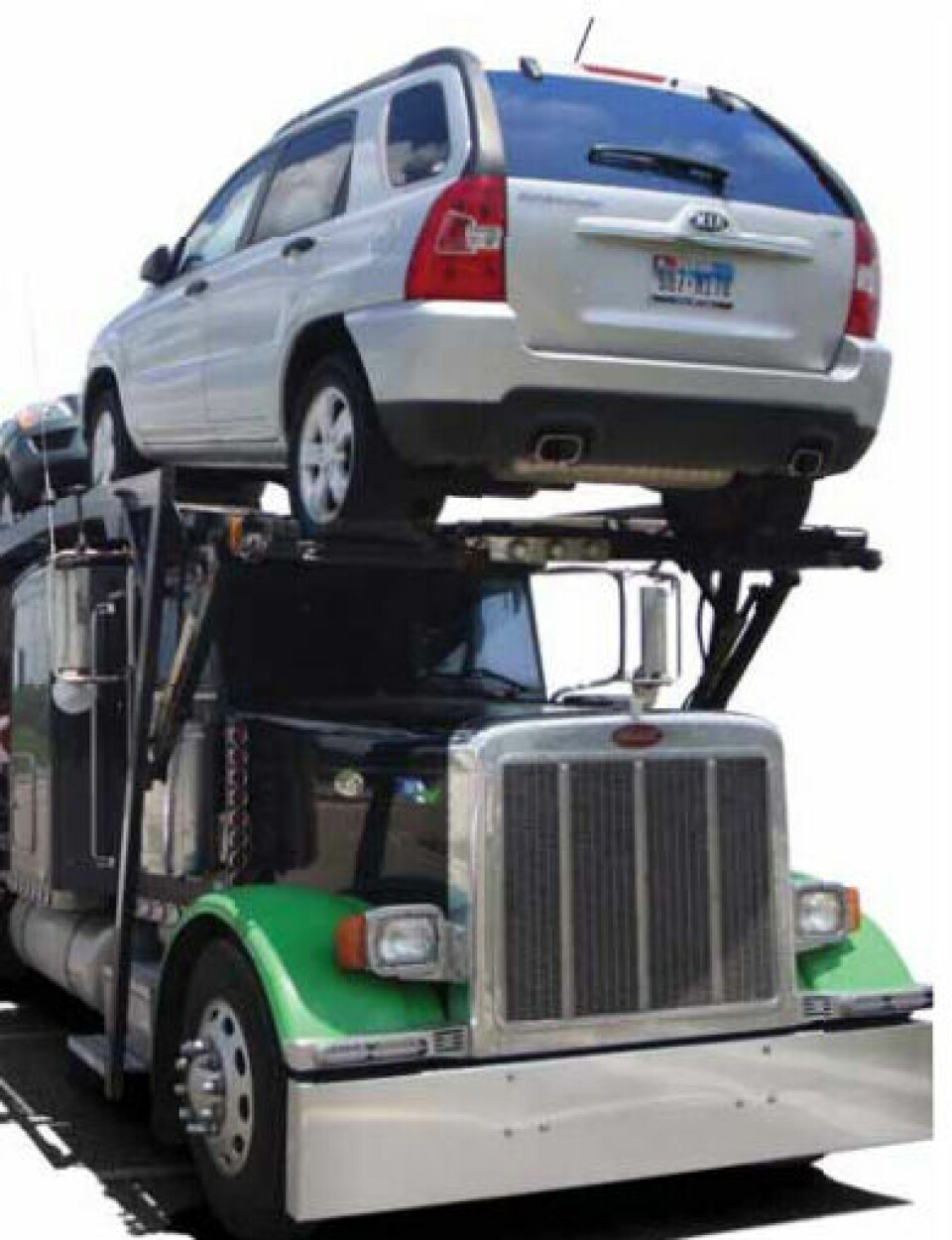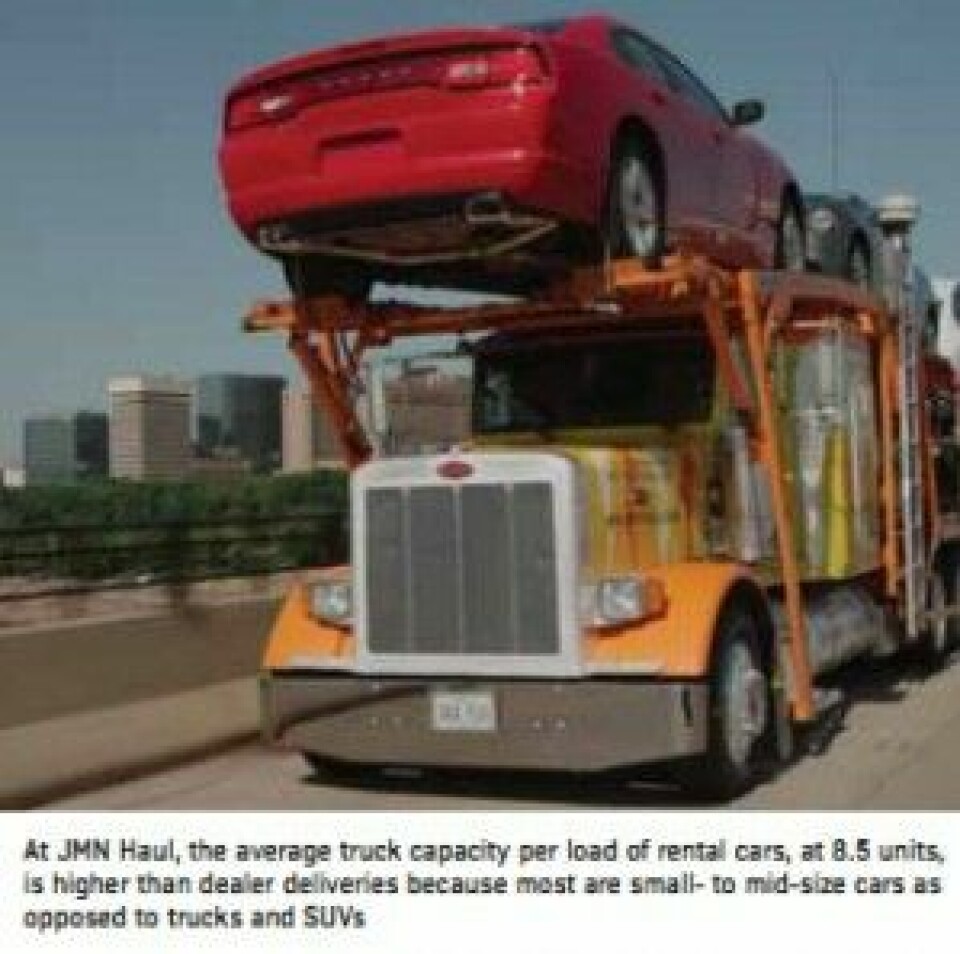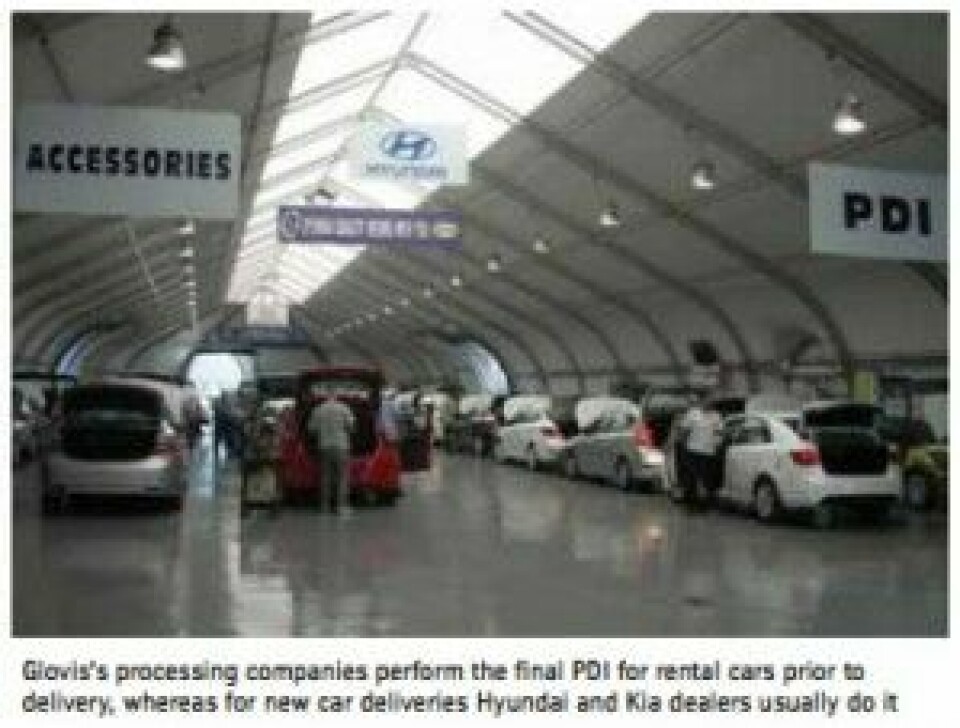Trailers for sales or rental
The delivery and service opportunities offered to logistics providers by the growing rental and fleet markets of the US and Europe. With additional reporting by Christopher Ludwig.

While many OEMs, particularly in North America, have tried to reduce the proportion of their fleet sales relative to retail in an effort to maintain pricing, the fleet and rental markets are nevertheless growing and important parts of the US and European automotive sectors. For vehicle logistics providers, deliveries to the rental market, and the associated remarketed vehicles sold out of fleets, represent an opportunity to increase network volume and potentially increase load factors for pickups from ports or railheads. In future, the rise of car-sharing schemes, particularly in Europe, could also lead to new delivery and service flows for vehicle logistics providers.
“The rental industry represents a small, but growing portion of the vehicles that we move,” says Kathleen McCann, chief executive officer for United Road Services, one of the largest hauliers in the US. “United Road is handling relatively more new and remarket rentals thanks to our value proposition that includes national reach and on-time delivery. Our technology builds and optimises loads and routes using all relevant data points including geo-spatial information, VINs, etc.”
The car rental industry in the United States amounts to a considerable and complex market – in 2011 it represented a fleet of more than 1.76m active vehicles across the country, with nearly 18,000 rental locations, according to data compiled by Auto Rental News (ARN). Enterprise Holdings (which includes Enterprise, National and Alamo) holds the largest average fleet in the US at nearly 921,000 vehicles, followed by Hertz with 320,000 vehicles (although Hertz reports a fleet nearly double this size), Avis Budget Group with 285,000 vehicles and the Dollar Thrifty Automotive Group (DTG) with 118,000. In August, DTG reached an agreement to merge with Hertz for $2.3 billion.
Also in 2011, sales of fleet vehicles, including customers beyond the rental companies, totalled more than 2.1m vehicles among the top seven carmakers in the US – 7% more than in 2010. US carmakers are still the largest customers despite decreasing fleet sales in recent years, with Ford selling 680,000 such vehicles and GM nearly 640,000.
As the largest OEM customers are the same for fleet cars as they are for dealer deliveries, moving rental cars presents many of the same logistics challenges as delivering to dealerships when it comes to transport modes, network engineering and performance indicators such as on-time, low damage and cost-effective delivery. But for logistics providers getting involved directly in movements for the rental market, there are differences and complications for which they must be prepared. For example, the mass delivery movements required for delivering fleets could require added resources and IT capabilities for scheduling vehicles through processing centres and communicating with rental agencies, particularly as such companies tend to have less advanced technology for monitoring vehicles. Once rental vehicles are ready for de-fleeting (removal from current inventory), the logistics process also presents complexities in the remarketing phase.
damage and cost-effective delivery. But for logistics providers getting involved directly in movements for the rental market, there are differences and complications for which they must be prepared. For example, the mass delivery movements required for delivering fleets could require added resources and IT capabilities for scheduling vehicles through processing centres and communicating with rental agencies, particularly as such companies tend to have less advanced technology for monitoring vehicles. Once rental vehicles are ready for de-fleeting (removal from current inventory), the logistics process also presents complexities in the remarketing phase.
Rental car delivery networks
The distribution network used to move rental cars is, at least to the point of handover to a rental company, largely the same as for moving large quantities of retail vehicles. For example, Glovis America, Hyundai’s logistics subsidiary, shipped about 115,000 of Hyundai-Kia’s new fleet vehicles in 2011, which equalled approximately 9.5% of its total new car distribution in the US, according to Art Lim, director of operations at Glovis. The Hyundai and Kia brands sold around 149,000 fleet vehicles in 2011, a nearly 30% decline from 2010 as the group diverted limited inventory to retail sales.
Although the numbers have declined, Glovis views new rental cars as volume that can be supplemented and co-mingled with dealer flows to improve network efficiency. Approximately 48% of its new rental cars move by rail as their primary transport mode and 52% move by truck (the same modal split that Glovis has for dealer deliveries).
Lim says that around 58% of fleet vehicles for Hyundai and Kia originate from the group’s Alabama and Georgia plants, with the rest imported mainly from South Korea. Glovis uses primarily the same ports to import new rental cars as it does retail vehicles, including Portland, Oregon; Brunswick, Georgia; and Philadelphia, Pennsylvania, among others. It also uses two inland processing centres in Texas.
Once vehicles reach rental agencies, however, these companies often have their own distribution infrastructure and drivers to serve rental points, mainly with storage centres at outlets positioned close to airports, but also at specific vehicle drop-off points and distribution centres to serve individual markets. Glovis delivers all of its fleet vehicles directly to rental outlets.
Tim Trast, delivery vehicle technician at Alamo Rent A Car in Austin, Texas says that he expects to receive 3,500 new vehicles between mid-August and November. The Alamo/ National vehicle distribution centre is located on the grounds of Austin-Bergstrom International Airport. Its capacity is 400 units, which includes new stock as well as returns and vehicles currently active in the fleet. “The airport is a good location because it has space availability,” says Trast.
Alamo Austin handles about 75% of the pre-delivery inspection (PDI) process and attaches the licence plates. Inspectors do the remainder of the PDI, including fluid level checks and other steps. Vehicles are then driven individually to the airport or other branches. Alamo Austin uses between 80 and 90 drivers to deliver to between 60 and 70 rental outlets in the area.
“Our delivery hours are from 6am to 9pm, but we do not make appointments,” reveals Trast. “Thus, although we know the number of vehicles to expect, we do not know when they will arrive.”
The role of logistics providers
While many rental companies transport and position vehicles in their active fleets themselves, vehicle logistics providers are involved in the delivery of new vehicles as well as moving cars for remarketing. There also appears to be considerable scope for bringing more of the advanced tracking and network monitoring that specialists have developed for retail deliveries.
Metrogistics, based in St. Louis, Missouri (which is also where Enterprise has its headquarters) is a logistics service provider using both its own trucks and a wider carrier network to haul vehicles for a range of customers, including the rental market. New rentals represent about 10% of Metrogistics’ annual volume of around 800,000 vehicles, while remarketed rentals make up about 20%, according to managing partner Scott Naz. Of its new rental vehicles, 90% are bound for rental outlets and the remainder go to distribution centres. “We use the latter if the location is landlocked, such as an airport, or if the rental outlet is full,” he says.

Another company that is seeing growth in logistics for new rental cars is JMN Logistics – also based near St. Louis – which delivers 40,000-45,000 new rental units annually, about 10% of the company’s current volume, according to Cindy Darnell, chief operating officer. Remarketed rental cars account for another 25% of its volume.
JMN Logistics picks up 95% of its new rental units at railheads, and loads another 5% at OEMs’ offsite storage yards. All of JMN’s deliveries go directly to rental outlets, of which 95% are located at airports. JMN serves a number of rail terminals in the southeast and the midwest. It may deliver 300-500 cars to a single outlet at one time.
At United Road Services, McCann says that the company serves most rental companies in its local, daily and airport operations. It delivers new vehicles to rental outlet locations and to drop-ship locations at which the rental companies aggregate their orders.

Noting the difference
There are several notable differences between rental and dealer deliveries. One is in load factors, explains JMN’s Darnell. For example, the average truck capacity per load of rental cars, at 8.5 units, is higher than dealer deliveries because most are small- to mid-size cars as opposed to trucks and SUVs.
For short hauls, rental delivery distances are typically 10-20 miles (15-30km) per load and a driver can handle two or three loads per day. With this frequency, Darnell says JMN Logistics wants every pick-up location to provide at least 20% new rental cars to supplement dealer deliveries, at the same time as saving fuel by building as many loads as possible with one pick-up point and one drop-off point.
“Some origin facilities provide fewer rental cars, so we mix new rental cars with new dealer cars,” says Darnell, who remarks that it is less common to combine new rentals and remarkets on the same truck due to the time it would take to service two drop-off locations. “OEMs also have rules concerning mixing new vehicles with remarkets,” she adds.
According to Glovis’s Lim, another important difference is that rental cars need fewer accessories, usually requiring only floor mats. On the other hand, they need different processing scheduling, as it is more common for Glovis’s processing companies to perform the final PDI for rental cars prior to delivery, whereas for new car deliveries Hyundai and Kia dealers usually perform it.
“We need to schedule more resources or take a bit away from dealers,” says Lim. “Rental vehicles require a PDI by vehicle processing companies prior to shipment so that vehicles can begin rental service shortly after delivery. The PDI process takes one hour per vehicle.”
Lim adds that one of Glovis’s main challenges is planning for sufficient labour and resources from the vehicle processing companies to ensure that new rental vehicles are processed and tendered to carriers in a timely manner. “This includes integrating our fleet car processing with that of our dealer vehicles,” says Lim.
Another difference from dealer deliveries is that rental vehicles are grouped in larger orders, which means Glovis may need to spread out the delivery of as few as ten or as many as 250 vehicles within a specific date range. “The schedule is fluid as to when rental cars need to ship, so we cannot process them too early,” says Lim. “By contrast, dealer vehicles receive a general ETA.”
But while rental vehicles might complicate processing schedules, the delivery and damage claims process tends to be simpler than for dealer deliveries. Darnell says that truck drivers often prefer to deliver rental cars because it takes only 35% of the time needed for dealer deliveries. “Basically, the receiver does not have the time to look as closely for nicks. Therefore, the claims rates are lower. We deliver most vehicles on a subject-to-inspection basis,” she explains.
Another advantage is that JMN can deliver its rental cars 24/7 to delivery points, whereas dealers usually have stricter delivery windows. Furthermore, it also obtains backhauls for remarketing units from store to store or from store to auction house. However, Lim adds that challenges for both rental and dealer deliveries include time restrictions on delivery or limits on the number of vehicles that may be delivered at one time or on one day.
According to McCann at United Road, the real difference in moving rental cars compared to dealer deliveries is the different use of technology at the rental agency level. Customers can access United Road’s Online Vehicle Information Shipping System (OVISS) to determine where cars are in the delivery process, but rental companies are often less familiar with such systems.
“[A rental agency] is not as advanced as at the typical dealer,” reckons McCann. “Dealers are more accustomed to integrating United Road’s technology. The tools are available and the more that rental agencies integrate them, the greater the added value.”
Remarketing potential
For most logistics companies, the remarketing phase for rental vehicles represents a large volume potential for moving vehicles, considering the quick churn of vehicles in rental fleets and subsequent auctions. Metrogistics’ distribution channels include auction houses, wholesalers, and dealers. It transports some of these units to sizable auction houses in the US such as Mannheim and ADESA, as well as to some independent auctions.
Naz says that many of its customers are trying to meet a specific sale date, so timeliness of delivery is critical. Most sales are weekly and some special sales can take place monthly or quarterly. “The biggest challenge can be locating the vehicles, since the lots are very large and units move around constantly,” he points out.
Speed is an important factor in the remarketing phase. If a customer needs 40 units delivered from Milwaukee to Dallas in two days to make a sale, there is a lot of pressure on the carrier. If the carrier misses the delivery date, it can push units to the next sale date, which adds costs because of the delays, says Naz.
Metrogistics also provides store-to-store transfers for remarketed rentals, which make up around 10% of the company’s rental moves. Naz says that many of these moves are from the southeast to the midwest or from Florida to other parts of the southeast. A third category of rental remarkets is direct sales, which represent about 80,000 vehicles per year for the company. Of these, 50% go to wholesalers, 30-50% go to dealers, and 1-2% go to single customers. Direct sales come from both auctions and rental outlets.
Among Metrogistics’ customers is Dollar Thrifty. Randy Rawlinson, director of remarketing for DTG Operations, based in Tulsa, Oklahoma, says that when vehicles are de-fleeted, they go through a number of channels including direct sales. “If we do not sell the cars, then we truck them to auction. The advantage of Metrogistics is that it has access to a wide range of carriers. We already know the rate and Metrogistics monitors the quality of the shipments and qualifies the truckers,” he says.

The future of sharing?
While the new and remarketed rental car market has similarities with the delivery of dealer vehicles, and is often integrated into the networks of logistics companies, it is a segment that offers potential for providers to bring new expertise in network engineering, processing and IT connectivity. With growth in volume expected, it’s likely to offer further opportunities, not least in Europe, where the retail market is generally declining. One area that still appears somewhat off the radar of many logistics providers is that of car-sharing schemes, which consultants Frost & Sullivan expects to increase from 700,000 subscribers in Europe today to 15m by 2020. The number of vehicles in such schemes is also expected to increase from 21,000 in 2011 to nearly 240,000 by 2020 – remarketing of such vehicles would be likely to grow as well.
While such a market would remain small compared to the wider private and traditional rental market, and may see less traction in the US (where Zipcar’s 2011 fleet was still just 7,400 vehicles), it does nevertheless appear to have potential delivery and service opportunities for transport and IT providers. Even if this potential remains small for the time being, for vehicle logistics providers – who in many ways operate in a nearly captive market – the rental and car sharing market could offer otherwise rare opportunities to diversify.





